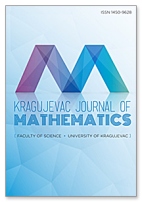Skew Hurwitz Series Rings and Modules With Beachy-Bliar Conditions
 Download PDF
Download PDF
Authors: R. K. SHARMA AND A. B. SINGH
DOI: 10.46793/KgJMat2304.511S
Abstract:
A ring R satisfies the right Beachy-Blair condition if for every faithful right ideal J of a ring R (that is, a right ideal J of a ring R is faithful if rR(J) = 0) is co-faithful (that is, a right ideal J of a ring R is called co-faithful if there exists a finite subset J1 ⊆ J such that rR(J1) = 0). In this note, we prove two main results.
- Let R be a ring which is skew Hurwitz series-wise Armendariz, ω-compatible and torsion-free as a ℤ-module, and ω be an automorphism of R. If R satisfies the right Beachy-Blair condition then the skew Hurwitz series ring (HR,ω) satisfies the right Beachy-Blair condition.
- Let MR be a right R-module which is ω-Armendariz of skew Hurwitz series type and torsion-free as a ℤ-module, and ω be an automorphism of R. If MR satisfies the right Beachy-Blair condition then the skew Hurwitz series module HM(HR,ω) satisfies the right Beachy-Blair condition.
Keywords:
Ring with right Beachy-Blair condition, right R-module with right Beachy-Blair condition, skew Hurwitz series ring, skew Hurwitz series module, reduced ring, ω-compatible ring, ω-compatible module, ω-reduced module.
References:
[1] M. Ahmadi, A. Moussavi and V. Nourozi, On skew Hurwitz serieswise Armendariz rings, Asian-European J. Math. 7(3) (2014), 1–17. https://doi.org/10.1142/S1793557114500363
[2] D. D. Anderson and V. Camillo Armendariz rings and Gaussian rings, Comm. Algebra 26(7) (1998), 2265–2272. https://doi.org/10.1080/00927879808826274
[3] S. Annin, Associated primes over Ore extensions rings, J. Algebra Appl. 3(2) (2004), 193–205. https://doi.org/10.1142/S0219498804000782
[4] J. A. Beachy and W. D. Blair, Rings whose faithful left ideals are cofaithful, Pacific. J. Math. 58(1) (1975), 1–13. https://projecteuclid.org/euclid.pjm/1102905834
[5] A. Benhissi and F. Koja, Basics of Hurwitz series rings, Ricerche Mathematica 61 (2012), 255–273. https://doi.org/10.1007/s11587-012-0128-2
[6] S. Bochner and W. T. Martin, Singularities of composite functions in several variables, Annals of Math. 38(2) (1937), 293–302. https://doi.org/10.2307/1968554
[7] F. Cedó, Zip rings and Mal’cev domains, Comm. Algebra 19(7) (1991), 1983–1991. https://doi.org/10.1080/00927879108824242
[8] W. Cortes, Skew polynomial extensions over zip rings, Int. J. Math. Math. Sci. 10 (2008), 1–8. https://doi.org/10.1155/2008/496720
[9] G. B. Desale and K. Varadarajan, Extension of result of Beachy and Blair, Proc. Amer. Math. Soc. 84(3) (1982), 335–338. https://doi.org/10.2307/2043554
[10] C. Faith, Rings with zero intersection property on annihilators: zip rings, Publ. Math. 33(2) (1989), 329–338. https://www.jstor.org/stable/43737136
[11] C. Faith, Annihilator ideals, associated primes and Kasch-McCoy commutative rings, Comm. Algebra 19(7) (1991), 1867–1892. https://doi.org/10.1080/00927879108824235
[12] M. Fliess, Sur divers produits de series fonnelles, Bull. Soc. Math. France 102 (1974), 181–191. https://doi.org/10.24033/bsmf.1777
[13] E. Hashemi and A. Moussavi, Polynomial extensions of quasi-Baer rings, Acta. Math. Hung. 1073 (2005), 207–224. https://doi.org/10.1007/s10474-005-0191-1
[14] A. M. Hassanein, Clean rings of skew Hurwitz series, Le Matematiche LXII(1) (2007), 47–54.
[15] A. M. Hassanein and M. A. Farahat, Some properties of skew Hurwitz series, Le Matematiche LXIX(1) (2014), 169–178. https://doi.org/10.4418/2014.69.1.12
[16] Y. Hirano, On annihilator ideals of a polynomial ring over a noncommutative ring, J. Pure Appl. Algebra 168(1) (2000), 45–52. https://doi.org/10.1016/S0022-4049(01)00053-6
[17] C. Y. Hong, N. K. Kim and T. K. Kwak, On skew Armendariz rings, Comm. Algebra 31(1) (2003), 103–122. https://doi.org/10.1081/AGB-120016752
[18] C. Y. Hong, N. K. Kim, T. K. Kwak and Y. Lee, Extension of zip rings, J. Pure Appl. Algebra 195(3) (2005), 231–242. https://doi.org/10.1016/j.jpaa.2004.08.025
[19] A. Hurwitz, Sur un thèorème de M. Hadamard, C. R. Math. Acad. Sci. 128 (1899), 350–353. https://doi.org/10.1007/978-3-0348-4161-0_27
[20] W. F. Keigher, Adjunctions and comonads in differential algebra, Pacific J. Math. 59(1) (1975), 99–112. https://doi.org/10.2140/pjm.1975.59.99
[21] W. F. Keigher, On the ring of Hurwitz series, Comm. Algebra 25(6) (1997), 1845–1859. https://doi.org/10.1080/00927879708825957
[22] W. F. Keigher. and F. L. Pritchard, Hurwitz series as formal functions, J. Pure Appl. Algebra 146 (2000), 291–304. https://doi.org/10.1016/S0022-4049(98)00099-1
[23] N. K. Kim, K. H. Lee and Y. Lee, Power series rings satisfying a zero divisor property, Comm. Algebra 34(6) (2006), 2205–2218. https://doi.org/10.1080/00927870600549782
[24] T. K. Lee and Y. Zhou, Reduced modules: Rings, Modules, Algebras and Abelian Groups, Lecture Notes in Pure and Appl. Math. 236, Marcel Dekker, New York, 2004, 365–377. https://doi.org/10.1201/9780824750817.ch29
[25] Z. Liu, Hermite and PS-rings of Hurwitz series, Comm. Algebra 28(1) (2000), 299–305. https://doi.org/10.1080/00927870008841073
[26] Z. Liu and Y. Xiaoyan, On annihilator ideals of skew monoid rings, Glasgow Math. J. 52(1) (2010), 161–168. https://doi.org/10.1017/S0017089509990255
[27] A. Lovery and J. Matczuk, Zip property of certain ring extensions, J. Pure Appl. Algebra 220(1) (2016), 335–345. https://doi.org/10.1016/j.jpaa.2015.06.015
[28] L. Ouyang, J. Liu, and Y. Xiang, Modules with the Beachy-Blair condition, Comm. Algebra 42(2) (2014), 853–871. https://doi.org/10.1080/00927872.2012.727932
[29] L. Ouyang, J. Liu, and Y. Xiang, Extensions of zip modules, Adv. Math. (China) 43(5) (2014), 683–694. https://doi.org/10.11845/sxjz.2012163b
[30] J. Okniński, Semigroup Algebras, Monographs and Textbooks in Pure and Applied Mathematics 136, Marcel Dekker, New York, 1991.
[31] K. Paykan, Nilpotent elements of skew Hurwitz series rings, Rend. Circ. Mat. Palermo 2 65(3) (2016), 451–458. https://doi.org/10.1007/s12215-016-0245-y
[32] K. Paykan, Principally quasi-Baer skew Hurwitz series rings, Boll. Unione Mat. Ital. 10(4) (2016), 607–616. https://doi.org/10.1007/s40574-016-0098-5
[33] K. Paykan, A study on skew Hurwitz series rings, Ricerche Mat. 66 (2017), 383–393. https://doi.org/10.1007/s11587-016-0305-9
[34] E. Rodríguez-Jorge, Rings with the Beachy-Blair condition, J. Algebra Appl. 11(1) (2012). https://doi.org/10.1142/S0219498811005300
[35] R. K. Sharma and A. B. Singh, Unified extensions of strongly reversible rings and links with other classic ring theoretic properties, J. Indian Math. Soc. 85(3–4) (2018), 434–447. https://doi.org/10.18311/jims/2018/20986
[36] R. K. Sharma and A. B. Singh, Zip property of skew Hurwitz series rings and modules, Serdica Math. J. 45(1) (2019), 35–54.
[37] A. B. Singh and V. N. Dixit, Unification of extensions of zip rings, Acta Univ. Sapientiae Math. 4(2) (2012), 168–181.
[38] E. J. Taft, Hurwitz invertibility of linearly recursive sequences, Congr. Numer. 73 (1990), 37–40.
[39] J. M. Zelmanowitz, The finite intersection property on annihilator right ideals, Proc. Amer. Math. Soc. 57(2) (1976), 213–216. https://doi.org/10.2307/2041191
[40] C. P. Zhang and J. L. Chen, Zip Modules, Northeastern Mathematical Journal 24(3) (2008), 233–249.
